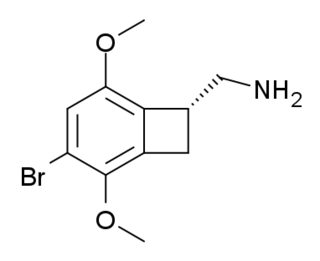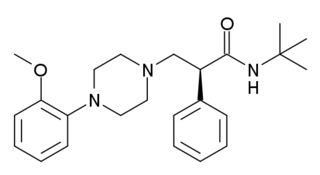
The 5-HT2A receptor is a subtype of the 5-HT2 receptor that belongs to the serotonin receptor family and is a G protein-coupled receptor (GPCR). The 5-HT2A receptor is a cell surface receptor, but has several intracellular locations. 5-HT is short for 5-hydroxy-tryptamine or serotonin. This is the main excitatory receptor subtype among the GPCRs for serotonin, although 5-HT2A may also have an inhibitory effect on certain areas such as the visual cortex and the orbitofrontal cortex. This receptor was first noted for its importance as a target of serotonergic psychedelic drugs such as LSD and psilocybin mushrooms. Later it came back to prominence because it was also found to be mediating, at least partly, the action of many antipsychotic drugs, especially the atypical ones.

A serotonin receptor agonist is an agonist of one or more serotonin receptors. They activate serotonin receptors in a manner similar to that of serotonin, a neurotransmitter and hormone and the endogenous ligand of the serotonin receptors.

TCB-2 is a hallucinogen discovered in 2006 by Thomas McLean working in the lab of David Nichols at Purdue University. It is a conformationally-restricted derivative of the phenethylamine 2C-B, also a hallucinogen, and acts as a potent agonist for the 5-HT2A and 5-HT2C receptors with a Ki of 0.26 nM at the human 5-HT2A receptor. In drug-substitution experiments in rats, TCB-2 was found to be of similar potency to both LSD and Bromo-DragonFLY, ranking it among the most potent phenethylamine hallucinogens yet discovered. This high potency and selectivity has made TCB-2 useful for distinguishing 5-HT2A mediated responses from those produced by other similar receptors. TCB-2 has similar but not identical effects in animals to related phenethylamine hallucinogens such as DOI, and has been used for studying how the function of the 5-HT2A receptor differs from that of other serotonin receptors in a number of animal models, such as studies of cocaine addiction and neuropathic pain.

A-372159 is a drug which acts as a potent and selective partial agonist for the 5HT2C receptor, with more than 100x selectivity over the closely related 5-HT2B receptor and a Ki of 3nM. It has been found to produce anorectic effects in animal studies and produced significant weight loss in rats with no development of tolerance or serious side effects.

YM-348 is an indazole derivative drug which acts as a potent and selective 5-HT2C receptor agonist, with an EC50 of 1nM and 15x selectivity over 5-HT2A, although it only has moderate selectivity of 3x over the closely related 5-HT2B receptor. It has thermogenic and anorectic effects in animal studies, making it potentially useful for the treatment of obesity.

BW-723C86 is a tryptamine derivative drug which acts as a 5-HT2B receptor agonist. It has anxiolytic effects in animal studies, and is also used for investigating the function of the 5-HT2B receptor in a range of other tissues.

Ro60-0175 is a drug developed by Hoffmann–La Roche, which has applications in scientific research. It acts as a potent and selective agonist for both the 5-HT2B and 5-HT2C serotonin receptor subtypes, with good selectivity over the closely related 5-HT2A subtype, and little or no affinity at other receptors.

WAY-100135 is a serotonergic drug of the phenylpiperazine family which is used in scientific research. It acts as potent 5-HT1A receptor antagonist, and was originally believed to be highly selective, but further studies have demonstrated that it also acts as a partial agonist of the 5-HT1D receptor (pKi = 7.58; virtually the same affinity for 5-HT1A), and to a much lesser extent, of the 5-HT1B receptor (pKi = 5.82). These findings may have prompted the development of the related compound WAY-100635, another purportedly selective and even more potent 5-HT1A antagonist, which was synthesized shortly thereafter. However, WAY-100635 turned out to be non-selective as well, having been shown to act additionally as a potent D4 receptor agonist later on.

AL-37350A (4,5-DHP-AMT) is a tryptamine derivative which acts as a potent and selective agonist for the serotonin receptor 5-HT2A, with a Ki of 2.0 nM, and moderate selectivity over the related 5-HT2B and 5-HT2C receptors. It has been shown to have ocular hypotensive activity in animal models, suggesting it may be useful for the treatment of glaucoma.

Eptapirone (F-11,440) is a very potent and highly selective 5-HT1A receptor full agonist of the azapirone family. Its affinity for the 5-HT1A receptor was reported to be 4.8 nM (Ki), and its intrinsic activity approximately equal to that of serotonin.

RH-34 is a compound which acts as a potent and selective partial agonist for the 5-HT2A serotonin receptor subtype. It was derived by structural modification of the selective 5-HT2A antagonist ketanserin, with the 4-(p-fluorobenzoyl)piperidine moiety replaced by the N-(2-methoxybenzyl) pharmacophore found in such potent 5-HT2A agonists as NBOMe-2C-B and NBOMe-2C-I. This alteration was found to retain 5-HT2A affinity and selectivity, but reversed activity from an antagonist to a moderate efficacy partial agonist.

CP-93129 is a drug which acts as a potent and selective serotonin 5-HT1B receptor agonist, with approximately 150x and 200x selectivity over the closely related 5-HT1D and 5-HT1A receptors. It is used in the study of 5-HT1B receptors in the brain, particularly their role in modulating the release of other neurotransmitters.

PRX-08066 is a drug discovered and developed by Predix Pharmaceuticals [Dale S. Dhanoa et al. Patent US 7,030,240 B2], which acts as a potent and selective antagonist at the serotonin 5-HT2B receptor, with a 5-HT2Bbinding affinity (Ki) of 3.4nM, and high selectivity over the closely related 5-HT2A and 5-HT2C receptors and other receptor targets. PRX-08066 and other selective 5-HT2B antagonists are being researched for the treatment of pulmonary arterial hypertension, following the discovery that the potent 5-HT2B agonist norfenfluramine produces pulmonary arterial hypertension and subsequent heart valve damage. In animal studies, PRX-08066 has been found to reduce several key indicators of pulmonary arterial hypertension and improved cardiac output, with similar efficacy to established drugs for this condition such as bosentan, sildenafil, beraprost and iloprost. It is also being researched for potential anti-cancer applications, due to its ability to inhibit fibroblast activation.

Ro60-0213 is a drug developed by Hoffmann–La Roche, which acts as a potent and selective agonist for the 5-HT2C serotonin receptor, with more than 100x selectivity over other closely related serotonin receptor subtypes, and little or no affinity at other receptors. It was developed as a potential antidepressant, but was discontinued from clinical development at an early stage due to toxicity concerns. However the high selectivity of Ro60-0213 for 5-HT2C makes it of continued interest for research into serotonin receptors.

1-(2-Dimethylaminoethyl)dihydropyrano(3,2-e)indole (4,5-DHP-DMT) is a tricyclic tryptamine derivative which acts as a potent and reasonably selective partial agonist for the serotonin receptor 5-HT2A, with a Ki of 17.0 nM, and moderate selectivity over related serotonin receptors. It has lower 5-HT2 affinity and efficacy than the related compound AL-37350A, but higher lipophilicity.

5-MeO-NBpBrT is a N-substituted member of the methoxytryptamine family of compounds. Like other such compounds it acts as an antagonist for the 5-HT2A receptor, with a claimed 100x selectivity over the closely related 5-HT2C receptor. While N-benzyl substitution of psychedelic phenethylamines often results in potent 5-HT2A agonists, it had been thought that N-benzyl tryptamines show much lower efficacy and are either very weak partial agonists or antagonists at 5-HT2A, though more recent research has shown stronger agonist activity for 3-substituted benzyl derivatives. Extending the benzyl group to a substituted phenethyl can also recover agonist activity in certain cases.

DMBMPP, or 2-(2,5-dimethoxy-4-bromobenzyl)-6-(2-methoxyphenyl)piperidine, is a 2-benzylpiperidine analog of the hallucinogenic N-benzylphenethylamine 25B-NBOMe and was discovered in 2011 by Jose Juncosa in the group of David E. Nichols at Purdue University. DMBPP differs from 25B-NBOMe by having a piperidine ring conformed to the amine, making for a more rigid molecular structure than that of the open-chain 25B-NBOMe. The presence of the piperidine ring introduces two stereocenters, thus, four stereoisomers of this compound can be made.

SB-236057 is a compound which is a potent and selective inverse agonist for the serotonin receptor 5-HT1B, acting especially at 5-HT1B autoreceptors on nerve terminals. It produces a rapid increase in serotonin levels in the brain, and was originally researched as a potential antidepressant. However subsequent research found that SB-236,057 also acts as a potent teratogen, producing severe musculoskeletal birth defects when rodents were exposed to it during pregnancy. This has made it of little use for research into its original applications, yet has made it useful for studying embryonic development instead.

CP-132,484 is a tryptamine derivative which acts as a potent and selective agonist for the 5-HT2 family of serotonin receptors. It has reasonable selectivity for 5-HT2A and 5-HT2C subtypes over 5-HT2B, but is only slightly selective for 5-HT2A over 5-HT2C. This compound and several related analogues have been shown to have ocular hypotensive activity in animal models, suggesting they may be useful for the treatment of glaucoma.



















